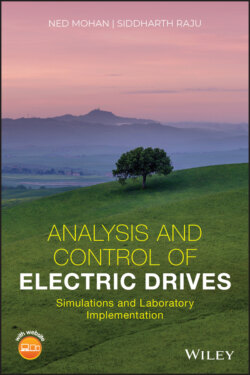Читать книгу Analysis and Control of Electric Drives - Ned Mohan - Страница 33
2‐2 SYSTEMS WITH LINEAR MOTION
ОглавлениеWe will begin by applying physical laws of motion in their simplest form, starting with linear systems. In Fig. 2-3a, a load of a constant mass M is acted upon by an external force fe that causes it to move in the linear direction x at speed u = dx/dt.
Fig. 2-3 Motion of a mass M due to the action of forces.
This movement is opposed by the load, represented by a force fL. The linear momentum associated with the mass is defined as M × u. As shown in Fig. 2-3b, in accordance with Newton’s Law of Motion, the net force fM(=fe − fL) equals the rate of change of momentum, which causes the mass to accelerate:
(2-1)
where a is the acceleration in m/s2, which from Eq. (2-1) is
(2-2)
In MKS units, a net force of 1 Newton (or 1 N), acting on a constant mass of 1 kg, results in an acceleration of 1 m/s2. Integrating the acceleration with respect to time, we can calculate the speed as
(2-3)
and, integrating the speed with respect to time, we can calculate the position as
(2-4)
where τ is a variable of integration.
The differential work dW done by the mechanism supplying the force fe is
(2-5)
Power is the time‐rate at which the work is done. Therefore, differentiating both sides of Eq. (2-5) with respect to time t, and assuming that the force fe remains constant, the power supplied by the mechanism exerting the force fe is
(2-6)
It takes a finite amount of energy to bring a mass to a speed from rest. Therefore, a moving mass has stored kinetic energy that can be recovered. Note that in the system of Fig. 2-3, the net force fM(=fe − fL) is responsible for accelerating the mass. Therefore, assuming that fM remains constant, the net power pM(t) going into accelerating the mass can be calculated by replacing fe in Eq. (2-6) with fM:
(2-7)
From Eq. (2-1), substituting fM as ,
(2-8)
The energy input, which is stored as kinetic energy in the moving mass, can be calculated by integrating both sides of Eq. (2-8) with respect to time. Assuming the initial speed u to be zero at time t = 0, the stored kinetic energy in the mass M can be calculated as
(2-9)
where τ is a variable of integration.
